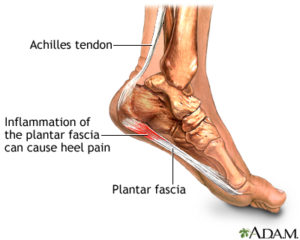“What’s wrong, John?” I said after I saw a player grimace between shots on the pickleball court. “My foot is killing me,” he said through clenched teeth.

Turns out he has plantar fasciitis. An extremely painful foot condition characterized by pain and inflammation in the plantar fascia, a thick band of tissue that runs across the bottom of your foot, connecting your heel bone to your toes. The plantar fascia provides support to the arch of your foot and helps absorb shock during walking and playing pickleball.
Luckily and fingers crossed, I have never experienced that kind of pain, but so many pickleball players have and it is debilitating usually causing them to suspend playing pickleball. Yikes! Having plantar fasciitis can ruin your pickleball game!
When the plantar fascia is excessively strained, it can develop small tears and become irritated, leading to plantar fasciitis. This condition is often caused by repetitive stress or overuse, such as playing pickleball too much. It can also be associated with certain risk factors, including flat feet, high arches, obesity, tight calf muscles, and wearing improper or unsupportive footwear.
The primary symptom of plantar fasciitis is pain on the bottom of the heel, which may be sharp or dull. The pain is usually worse in the morning when taking the first steps after waking up or after prolonged periods of rest. It may also worsen with activity and improve with rest. In some cases, the pain can extend along the arch of the foot.
Treatment for plantar fasciitis typically involves:
- Rest and activity modification: Avoiding activities that worsen the pain and giving the foot adequate rest.
- Applying ice packs to the affected area to reduce inflammation and pain.
- Stretching and strengthening exercises: Performing specific exercises to stretch the calf muscles and plantar fascia and strengthen the foot muscles.
- Orthotic devices: Wearing supportive shoes or using orthotic inserts to provide better arch support and cushioning.
- Medications: Nonsteroidal anti-inflammatory drugs (NSAIDs) may be recommended to alleviate pain and reduce inflammation.
- Make an appointment with a podiatrist or a physical therapist. They may provide additional treatment modalities like ultrasound therapy, massage, or taping techniques.
- Night splints: These devices keep the foot in a stretched position while sleeping to alleviate morning pain and stiffness.
- In severe cases, corticosteroid injections may be used to reduce pain and inflammation.
9. Surgery is rarely necessary and is typically reserved for cases that do not respond to conservative treatments after several months. I have met a couple of people who have had surgery though, with great results.
(Another good article to read. The Amazing Benefits of Rolling Out Your Feet)
How to avoid plantar fasciitis.
- Maintain a healthy weight.
- Choose supportive footwear or use inserts specially made for plantar fasciitis.
- Gradually increase activity levels: When starting a new exercise routine or increasing your physical activity, do so gradually. Sudden, intense activities can strain the plantar fascia. Allow your body time to adjust and strengthen gradually.
- Warm up and stretch: Before engaging in any physical activity, warm up your muscles and perform stretching exercises for your feet and calves. This helps prepare your muscles and reduces the risk of injury.
- Avoid prolonged standing or walking on hard surfaces: If your job or daily activities involve long periods of standing or walking on hard surfaces, try to take breaks, wear supportive shoes, or use cushioned mats to reduce the impact on your feet.
- Maintain a healthy foot posture: Practice good foot posture by avoiding excessive rolling inwards (pronation) or outwards (supination) of the feet. If you have any foot abnormalities or imbalances, consider using orthotic inserts or arch supports prescribed by a podiatrist.
- Strengthen your foot and leg muscles: Perform exercises to strengthen the muscles in your feet and lower legs, as strong muscles provide better support to the plantar fascia. Calf stretches, toe curls, and toe towel scrunches are some examples of exercises that can help.
- Take regular breaks from repetitive activities: If you have a job or hobby that involves repetitive foot movements (such as running or standing for long periods), try to take regular breaks and vary your activities to avoid overstraining the plantar fascia.
- Listen to your body: Pay attention to any foot pain or discomfort. If you experience persistent heel pain or other symptoms associated with plantar fasciitis, seek early treatment and avoid activities that worsen the pain.
If you’re experiencing persistent foot pain or suspect plantar fasciitis, it’s always important to consult a healthcare professional for an accurate diagnosis and appropriate treatment. Treat it before plantar fasciitis places you on the bench.
Thanks for reading,
Pickleball Terry, Founder and owner of Sarasota Pickleball Organization
941-400-0978 or dinkpickleball@gmail.com


